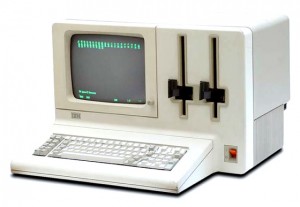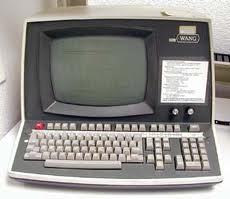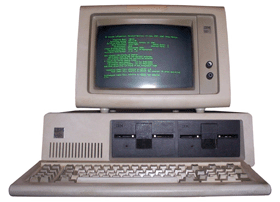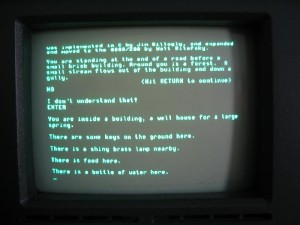A Break in the Clouds
Theme Songs Page | Previous Theme Song | Next Theme Song
A Break In The Clouds

Caverna Magica (… Under the Tree – In the Cave …), by Andreas Vollenweider (1983), encountered 1983
Like most people, I could never be morose all the time, any more than I could be happy all the time. When you’re young(ish) and you have your health and you have interesting work and there are people out there who like you, you’re not likely to spend all your time moping. There are bound to be things that will light up your eyes and hold your attention, and even make you feel good. And this held true for me even at a point when there was a big problem with my marriage
One of the things that certainly had that benign effect on me was getting my first computer.
Ghosts of Technology Past
Things have moved so quickly in the last thirty years that telling this story forces me to invoke ghosts of technology the reader may not even have heard of. But it can’t be told otherwise.
Back in 1980, computers were owned by companies and governments. Working at a computer meant sitting at a terminal and interacting with a “mainframe,” a very large and very hot machine that typically needed its own air conditioning system. Doing this work required extensive training that only a few people were lucky enough to receive.
For an aspiring lawyer, this meant interacting with the specially-trained women (it was mostly women) called word processors, who would sit in some central room not far from the mainframe, and would take your written or typed draft documents and input them into the computer, so that it would print out your documents as pages, either mechanically typed on glorified typewriters or buzzed onto pages by noisy dot-matrix printers.
Taking a Word Processor to Lunch
In that year, as I’ve written elsewhere, I was clerking at a big firm. In very up-to-date fashion, it had a room full of “word processors,”[1] toiling away at terminals for the firm’s IBM System 6. There were also a few terminals out at the secretarial stations. (Here’s what a terminal looked like.) [2]
[2]
I craved the control the word processors and the select secretaries had. All my life, being both an indifferent typist and a persnickety writer, I had found myself dissatisfied again and again with whatever I’d produced sitting over a keyboard and a platen. This led to many, many time- and patience-consuming retypings. Unlike me, these women could simply fix the problem and tell the printer to do the retyping. But of course no one was entrusting law clerks with control of one of these gizmos, let alone the training to operate them. We were simultaneously too high and too low on the totem pole. So I would hang around the word processing room just watching the women at work. I burned to know their secrets.
At last I hit on a plan. I approached one of the women and offered her a deal: I’d take her to lunch if she’d show me how her machine worked. She was agreeable, and allowed me, after the stipulated luncheon, to sit in her chair and touch the magic keys. I was entranced – and attentive. And having learned the rudiments from the lady, I embarked on a campaign of sitting at the secretarial workstations during their proprietors’ lunch breaks, and writing memos, and then longer works.
The System 6 took some learning, and it could be frustrating. I remember, for instance, one delete key it was easy to hit by accident. This would spark a minor disaster, since the key would delete the entire page you were working on in a single gulp. And I don’t think there was any “undo” key that would bring your page back. Still I forged ahead. I wrote an entire independent study project, later published in the Georgetown Law Journal (and republished in this blog) on that System 6.
Everybody Wang VS Tonight
I’ve also already written how after law school I went to work for the judge. If there was a word processor anywhere in that courthouse in 1981-82, I never met her, and I never saw any computer devoted to generating documents. But I made up my mind that I was going to push hard for my very own terminal at whatever firm I joined thereafter.
I’ve also written how I ended up at the firm I call Funhouse, P.A. Part of what drew me there was being told by the partner I’d report to that “we’ll have a lot of fun.” But part of it was being promised by the managing partner, upon my urgent request, that I’d get my own terminal. In fact, I’m sure that promise had clinched it for me.
I was to find out that that partner’s promises were not always to be relied upon. I think I was at Funhouse for three years before I actually received a terminal to their system: the Wang VS. But I would sneak into the word processors’ center after hours to write a novel[3] (and occasionally do billable work) on their system. It would be easy to make fun of the VS now, but that system really was the gold standard for law firms for a while. The terminal looked like this: [4]
[4]
This all absolutely whetted my desire to own an actual computer all by myself. And in 1981, it suddenly became theoretically possible, when IBM introduced what many call the first true personal computer, known by the chip that powered it, the Intel 8080. I’ve written in earlier pieces about lusts of the flesh: this was lust of the machine, and it was every bit as powerful – and more reliably satisfied as well.
But not cheaply. The hardware and the software were staggeringly expensive by modern standards. After long and obsessive shopping eventually led me to buy an 8080 (two floppy drives, no hard drive) with a monochrome text-based CRT monitor, a binder containing a floppy disk with an MS-DOS operating system, a binder of WordPerfect software, one Lotus spreadsheet program, and a single frivolity, the proto-computer game called Adventure: all for the price of around $5,000 in 1983 currency. Here’s what the 8080 looked like:  [5]
[5]
L’Avventura
The computer was installed in the converted attic of our home (we were now living in the very pleasant Oakenshawe neighborhood), and I would hide out there and romance the computer. I would write about my marital woes and hide the disks – and I would play Adventure, also known as The Colossal Cave Adventure.
In the modern era, when computer games mean handling a dedicated controller and walking your avatar down hellish galleries slaying orcs and aliens and bad guys that jump out at you with near photo-realism, it is difficult to convey the feel of Adventure, but there’s a great Wikipedia article that goes a long way toward conveying the experience. Adventure was a text-based game in which, by typing in directions, you found a way underground through a “springhouse” and entered a cave of many galleries, in which you came upon various helpful objects, were assaulted by and killed or were killed by dwarves, and encountered many wonders, as you attempted to assemble a number of hidden treasures.[6] For whatever reason, I never became much of a computer game devotee (solitaire games excepted), but this one did grab me, and I devoted a lot of hours to working on it.
 The fun lay, for me, not in the mathematical working through of the puzzle, but in getting to know the imaginary world, as primitively constructed as it was. And while happily embarked on this voyage, I would often listen to a cassette that made the perfect accompaniment: Andreas Vollenweider’s Caverna Magica (… Under the Tree – In the Cave …), also released in 1983. Vollenweider, a Swiss harpist, together with a small collective of collaborators, created a sort of psychedelic acoustic environment that definitely was also a cave filled with adventures. The cassette starts with the scuffling of feet on gravel as a man and a woman are exploring, and then one of them exclaims (in French?): “It’s a cave!” Shortly thereafter you hear water dripping from a stalactite or two, or three. The dripping slowly morphs into a jazzy rhythm, and then a mysterious whistling sound joins it, then the harp joins in, and you’re off on an amazing musical adventure. Each side of the tape is designed to be played straight through, although there are definite movements, with names that may mean something to Vollenweider but don’t tell us much. The movements on Side 1, for instance, are entitled: Caverna Magica, Mandragora, Lunar Pond, Schajah Saretosh, and Sena Stanjena?. It is bright, imaginative, and ever-shifting music.
The fun lay, for me, not in the mathematical working through of the puzzle, but in getting to know the imaginary world, as primitively constructed as it was. And while happily embarked on this voyage, I would often listen to a cassette that made the perfect accompaniment: Andreas Vollenweider’s Caverna Magica (… Under the Tree – In the Cave …), also released in 1983. Vollenweider, a Swiss harpist, together with a small collective of collaborators, created a sort of psychedelic acoustic environment that definitely was also a cave filled with adventures. The cassette starts with the scuffling of feet on gravel as a man and a woman are exploring, and then one of them exclaims (in French?): “It’s a cave!” Shortly thereafter you hear water dripping from a stalactite or two, or three. The dripping slowly morphs into a jazzy rhythm, and then a mysterious whistling sound joins it, then the harp joins in, and you’re off on an amazing musical adventure. Each side of the tape is designed to be played straight through, although there are definite movements, with names that may mean something to Vollenweider but don’t tell us much. The movements on Side 1, for instance, are entitled: Caverna Magica, Mandragora, Lunar Pond, Schajah Saretosh, and Sena Stanjena?. It is bright, imaginative, and ever-shifting music.
The Light at the End of the (Cave) Tunnel
The journey Vollenweider and friends charted out felt less sinister and dangerous than the one the programmers responsible for Adventure had contrived, but they each appealed to the same place in my head. Jointly these two creations, the game and the album, served as the perfect expression of the computer journey I embarked on at that point, one which has lasted all my years since then, and, doubtless, the rest of my life. You venture into mysterious places, develop new skills, and bring back all sorts of treasures from those mysterious caves we now call cyberspace.
But at that dark moment, they served a special purpose: reminding me that, outside of my private circle of misery, there was a world full of wondrous things. And if that world existed alongside the miserable one, I ought to be striking out for it, and not giving up to despair.
[1]. Actually, the first time I’d heard the word, two years before that, it had been used in a somewhat more modern sense. Commuting by train to Washington for my two years as a court reporter, I’d made friends with a fellow-commuter who sold “word processors” to the government. When he used the term, he meant computers dedicated to generating documents. But in the Baltimore legal world of the early 1980s, the term meant the people who ran those computers.
[3]. This was the “Conflicts of Interest” book described earlier.
[6]. According to the Wikipedia article: “Microsoft released a version of Adventure in 1981 with its initial version of MS-DOS 1.0 for the IBM PC (on a single sided disk, requiring 32kB of RAM). This was released on a 5¼ inch disk and booted directly from the disk. It could not be opened from DOS. This version contained 130 rooms, 15 treasures, 40 useful objects and 12 problems to be solved.”
Copyright (c) Jack L. B. Gohn, except for graphics